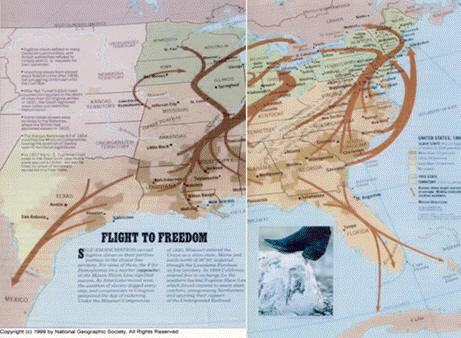
The
Underground Railroad
Wendell L. Haworth
Good morning!
In 30 short minutes
we're going to cover 2 and a half centuries (early-1600s to 1860) of
American and Quaker history surrounding The Underground Railroad….an activity
that aided and abetted criminal actions (based on the laws that existed in those
days) and over-turned conventional society of its time.
2.
Overview
}
What was The Underground
Railroad?
}
Background of the Underground
Railroad
}
Ha(y)worth Participants on the
Underground Railroad
First we’ll see what
The Underground Railroad was, then how it operated as a conduit for those
attempting to escape slavery in the pre-Civil War United States.
Next I'll cover
selected highlights of the political and socio-economic forces that, over the
period of early 1600s through 1865, evolved from an early-on wide-spread
acceptance of slavery, to a later divergence of thought on how slaves should be
treated and whether they should be considered as owned property or free. We'll
see how decisions made by the legislative, judicial and executive branches of
our United States government attempted to appease, but actually exacerbated
slave versus non-slave forces. We’ll also see how one of these forces, our
Quaker ancestors, took bold actions in a period of social turmoil that placed
them in jeopardy of possible arrest, fines and confinement, for assisting
fugitive slaves to escape from their masters.
Finally, I'll wrap
up with four documented examples of Haworth ancestors who directly participated
in operating The Underground Railroad.
3.
What was the
Underground Railroad?
Underground
Railroad Routes

The Underground
Railroad, a term first used about 1830, refers to neither underground nor a
railroad. It was a clandestine, informal organization of escape routes and
hideaway locations for runaway slaves fleeing from slave states in North America
to escape to the Free states, Canada, Mexico or even overseas locations, through
the mid-1860s. Railroads were the technological wonder of that age and use of
the term "Underground Railroad" probably captured the imagination of Americans
in associating with the loosely organized and haphazard escape routes and
support systems used by runaway slaves.
Most people
supporting the Underground Railroad only knew their part of the operation and
not of the whole system. Because of threats from Federal Marshalls and
professional bounty hunters, information about routes and safe havens was passed
along by word of mouth. Routes were often purposely indirect in order to throw
off pursuers.
4.
What was
the Underground Railroad?
}
UGRR Code Words
◦
Agents
◦
Passengers/Cargo
◦
Ticket
◦
Conductors
◦
Stations/Depots
◦
Station Masters
◦
Stockholders
Escaped slaves and
the people who aided them used many railroad-related terms as code words to
operate the Underground Railroad.
For example:
"Agents" made initial contact and assisted escapees, referred to as "Passengers"
or "Cargo," to obtain a "Ticket" on the railroad.
Individuals known as
"Conductors" guided the movement of runaways from station to station.
These "Stations," or
"Depots," were hiding places, often homes family homes, owned and/or operated by
"Station Masters," where the runaways could sleep and eat.
Those who provided assistance by money or supplies were called "Stockholders."
5.
What was the Underground
Railroad?
Wagon with False Bottom
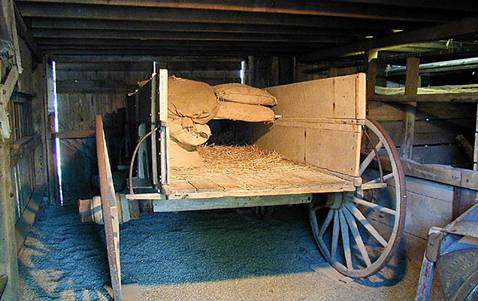
The escaped slaves
traveled by whatever means they could, sometimes by boat or on real railways,
but usually on foot or by wagon, moving almost entirely at night and hiding
during the day. These "passengers" generally covered about 10–20 miles per
night, stopping at the "stations" or "depots" during the day to eat and rest.
While resting at one station, a message would be sent to the next station master
that the runaways were on their way. Money was donated by many people to help
buy tickets and clothing for the fugitives so they would remain unnoticeable.
In the South and the
North, The Underground Railroad agents, conductors, station masters and
stockholders were free blacks and whites who provided the runaways with food,
clothing, directions, and places to hide. Some Southern slaves also helped
fugitives escape. In the North, many Quakers and other white abolitionists
furnished hiding places and helped slaves move from one station to the next.
6.
What was the Underground
Railroad?
Wanted Posters
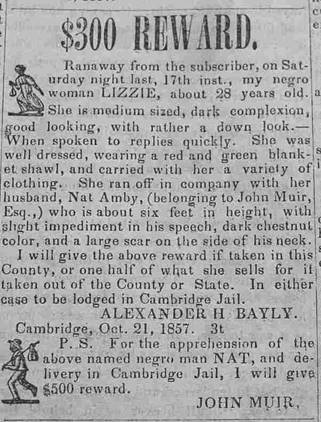

The risk of
discovery was great.
Federal marshals and
professional bounty hunters pursued fugitive slaves as far as the Canadian
border. In the South, every town erected special jails to house captured
runaways, and every newspaper carried numerous ads identifying fugitives in
great detail as to their physical descriptions, such as color, size, gender,
age, and physical markings, as well as their attitude.
The ads also
indicated where the fugitive was likely headed and sometimes their motives for
running away. Newspapers ran ads listing those slaves recently captured and
confined in jail. If the slave's owner did not claim a captured slave within a
short period of time, the runaway would be sold in a public auction.
The risk of capture
was not limited solely to actual fugitives. Because strong, healthy blacks in
their prime working and reproductive years were highly valuable commodities, it
was not unusual for free blacks — both freedmen, former slaves) and those who
had lived their entire lives in freedom — to be kidnapped and sold into slavery.
7.
What was the Underground
Railroad?

"Certificates of
freedom" — signed, notarized statements attesting to the free status of
individual blacks — could easily be destroyed and thus afforded their owners
little protection. Moreover, under the terms of the Fugitive Slave Law of 1850,
when suspected fugitives were seized and brought to a special magistrate known
as a commissioner, they had no right to a jury trial and could not testify in
their own behalf, since technically they were guilty of no crime; the marshal or
private slave-catcher only needed to swear an oath to acquire a writ of replevin,
for the return of property. (A writ of replevin is a prejudgment process
ordering the seizure or attachment of alleged illegally taken or wrongfully
withheld property to be held in the U.S. Marshal's custody or that of another
designated official, under order and supervision of the court, until the court
determines otherwise. This type of writ is commonly used to take property from
an individual wrongfully in possession of it and return it to its rightful
owner.)
8.
What was the Underground
Railroad?
Underground Railroad Routes
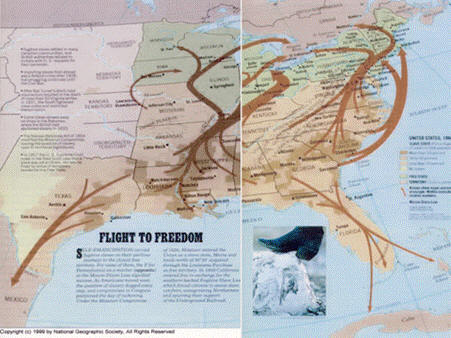
Almost from the
beginning of slavery in
The majority were
from the slave states which bordered the
The most heavily
traveled routes of the Underground Railroad ran through
9.
What was the Underground
Railroad?
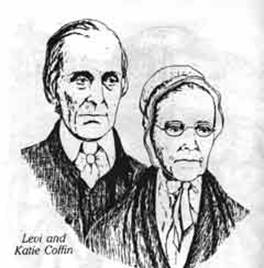

Several people
became famous for their work with the Underground Railroad. Levi Coffin, a
Quaker who was called the "president of the underground railroad," helped more
than 3,000 slaves escape. His home in
Perhaps the most
famous black leader of the Underground Railroad was Harriet Tubman, a runaway
slave herself. She returned to the South 19 times and helped about 300 blacks
escape to freedom.
10.
Underground Railroad Backdrop
}
Slavery has existed since
pre-historic times
}
Pre-1619 Colonial
◦
Native Americans
◦
Indentured Servants from
}
1619: First African slaves
arrived
}
1650: Best land in hands of
wealthy plantations
}
Gradual transition to
chattel slavery
It is difficult from
our present-day, 2009, perspective, 150-year removed from the times and events
surrounding the Underground Railroad, to understand the drastic political impact
and economic consequences its activities had on our nation, and what a
revolutionary idea and in-your-face (illegal?) movement it was to perpetrate.
Let's start by
looking at the backdrop in which the Underground Railroad originated and
operated.
First, the record of
slavery issues in
Slavery began in
prehistoric times and has been practiced as a matter of course by many cultures
around the world ever since.
In early Colonial
Europeans arrived at
the colonies in substantial numbers as indentured servants, who worked as
servants upon arrival to pay for the cost of their voyage.
The first record of
African slavery in Colonial
White citizens of
Virginia, who had arrived from Britain, decided to treat the first Africans in
By
1650, the best lands were already in the hands of wealthy
plantation families, consequently, when the former servants, indentured or
otherwise, became free from their servitude requirements; their chances for
gaining greater opportunities for prosperity of their were almost non-existent.
They became
disconcerted with their situation and posed a potentially precarious element to
the wealthy landowners. Several rebellions preceded a gradual transformation
from indentured servitude to chattel slaves who were the personal property of
slave owners.
11.
Underground Railroad Backdrop
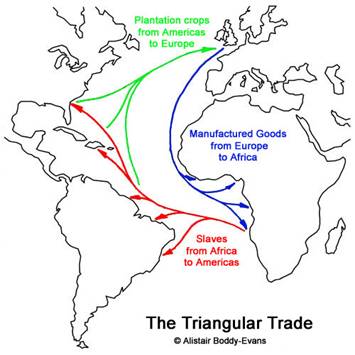
As the American
colonies were growing,
From the 1500s to
the mid-1800s, the Europeans are estimated to have shipped more than 12 million
black slaves from Africa to the
About 5 percent of
these slaves, or roughly 600,000 individuals, were brought to what is now the
Slavery played a
major role in the economic development of the
12.
Underground Railroad Backdrop
}
1750s: Sentiment grew
against slavery
}
1780-1804: Emancipation Acts
passed in all Northern states
}
1787:
◦
Congress prevented from banning importation of slaves until 1808
◦
“Three-Fifths Compromise” – in practice, benefitted slave holders
◦
Prior to 1850:
�
Southern presidents - 50 of 62 years
�
Southerner Supreme Court Justices-18 of 31 positions
Beginning in the
1750s, sentiment grew that
slavery was a social evil and should eventually be abolished.
All the Northern
states passed emancipation acts between 1780 and 1804; most of these arranged
for gradual emancipation and a special status for freedmen.
In
1787, The
Among its several
legislative components was one that prevented Congress from banning the
importation of slaves until 1808.
It also included the
“Three-Fifths Compromise,” a compromise between Southern and Northern states, in
which three-fifths of the population of slaves would be counted for enumeration
purposes regarding the distribution of taxes and the apportionment of members of
the
For example, in the
period prior to 1850, southerners held the Presidency for 50 of 62 years, and 18
of 31 Supreme Court Justice appointments despite the north having nearly twice
the population by 1850.
13.
Underground Railroad Backdrop
}
1793: Cotton Gin Invented

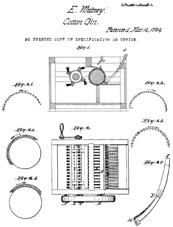
Whitney's invention of the cotton gin
14.
Underground Railroad Backdrop
}
1793: Cotton Gin Invented
}
January 1, 1808: Further
importation of slaves banned
}
1820s-1830s: Time of social
turmoil
◦
Protestant religious revivalism, charities
◦ Prohibition, prison and insane asylum reform, Labor unions, education
◦
Abolition movement
However, just as
demand for slaves was increasing, the supply was restricted. On January 1,
1808, at the earliest possible
Constitutionally-allowed date, Congress implemented measures that banned further
importation of slaves. Any new slaves would have to be descendants of ones
currently in the
The
1820's and 1830's
was a time of social turmoil.
Protestant religious
revivalism was sweeping the
Prohibitionists
pressed states to outlaw the sale of liquor. Women's participation in activities
outside the home became more socially acceptable, especially in the North.
Reformers campaigned to improve the dismal conditions in the nation's prisons
and "insane asylums." Workers joined labor unions to pressure employers to raise
wages, to improve working conditions, and to reduce the workday to 10 hours from
the usual 12 to 14 hours. Reformers also worked for better education, women's
rights, and the abolition of slavery.
In the early 1800's,
most good schools in the
In the 1800's,
American women had few rights. There were almost no colleges for women, and most
professional careers were closed to them. A married woman could not own
property; any property she had belonged to her husband. Women could not vote in
most elections. Many Americans believed in the idea of "separate spheres." This
idea held that women's sphere was the home and men's area of activity was the
larger world outside the home.
Finally, enter the
abolition movement as the most intense and controversial reform activity of the
period.
The growing strength
of the abolition movement made Southerners fear that the federal government
would outlaw slavery.
Southerners had
always argued that slavery was necessary to the plantation economy. Northerners,
on the other hand feared that the South would gain greater control of Congress
if Western territories entered the
15.
Underground Railroad Backdrop
}
Era of Compromises
Intensifies Slavery Issues:
◦
◦
Mexican-American War (ended 1848)
◦
Compromise of 1850
◦
Fugitive Slave Act
◦
1854 Kansas-Nebraska Act
◦
Dred Scott Decision
In order to maintain
a semblance of balance of slave vs. non-slave state power during this period of
rapid geographic expansion and fulfillment of the Doctrine of Manifest Destiny,
Congress entered into a number of compromises as new expanses of territory came
under United States control.
I'll briefly cover
these and the Dred Scott Decision, which brought the
16.
Underground Railroad Backdrop
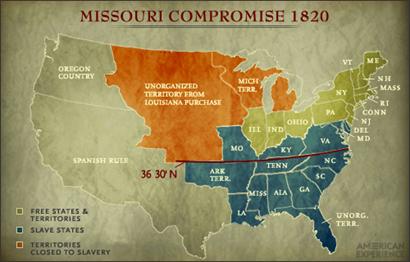
The
"
17.
Underground Railroad Backdrop
Mexican-American War Expansion
(1848)
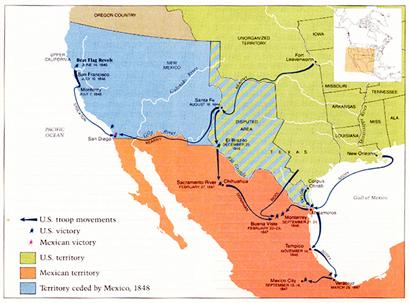
In 1848, the end of the "Mexican-American War" aggravated the dispute
between the North and South over the expansion of slavery. It was clear that the
newly acquired region, previously under Spanish rule, would be eventually split
up into territories and then states. Southerners argued against any limitations
on slavery in the new territories and states: while Northerners wanted the
federal government to ban slavery in the newly acquired lands. Some politicians
tried to compromise by proposing the "Rule of Popular Sovereignty" whereby
citizens of the territories and states would decide for themselves whether to
allow slavery.
In
1849,
18.
Underground Railroad Backdrop
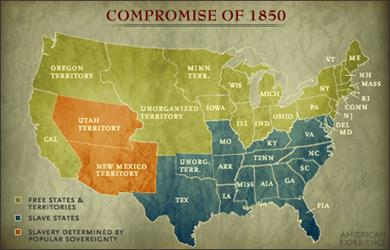
To calm the move
toward war, Congress passed the
Compromise of 1850 that, in effect, nullified the
Compromise of 1820. Its laws made concessions to both the North
and South. To satisfy the North,
19.
Underground Railroad Backdrop
Fugitive Slave Act
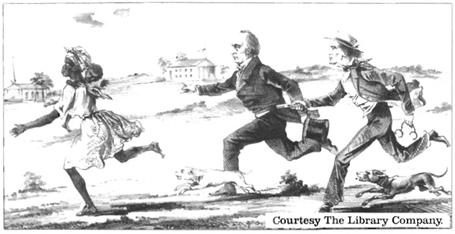
By 1850,
anti-slavery activities such as the Underground Railroad were becoming more
influential and successful. As a result, The Compromise of 1850 also
enacted the Fugitive Slave Act in an attempt to stop Northerners from
helping slaves who escaped into Northern states. It required that if an escaped
slave was sighted, he or she must be apprehended and turned in to the
authorities for deportation back to the "rightful" owner in the south. Federal
marshals were required to capture suspected fugitives and return them to the
South and were entitled to a bonus for their work. It contained a heafty penalty
of $1,000 for anyone who refused to return a runaway slave. The suspected slave
could not ask for a jury trial or testify on his or her own behalf. In addition,
any person aiding a runaway slave by providing food or shelter was subject to
six months' imprisonment and a $1,000 fine.
The Fugitive
Slave Act enraged Northerners, as the federal government began enforcing
slavery everywhere in the country.
The Compromise of
1850 did not solve the problem of the expansion of slavery into the West. In
the early 1850's, Congress began considering the creation of more new
territories in the area roughly between
20.
Underground Railroad Backdrop
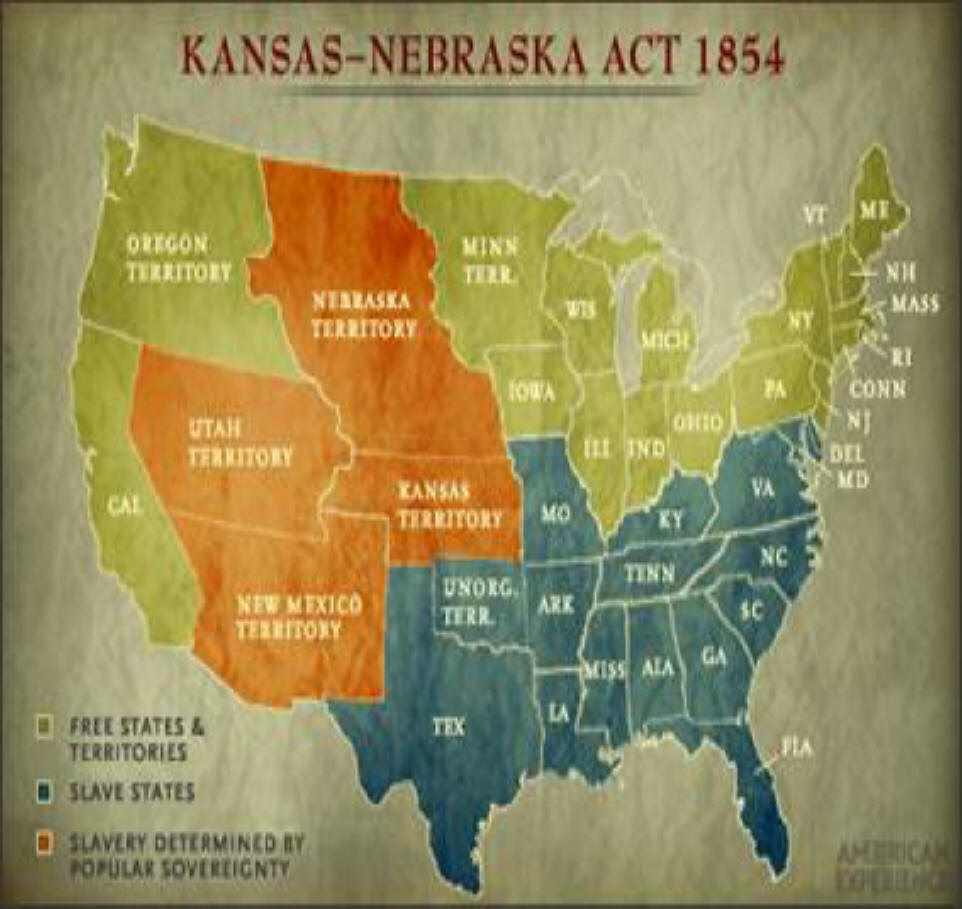
By 1854 the
Everywhere, angered
by the Kansas-Nebraska Act, attitudes for or against the slavery issue
toughened, and the possibility for further compromise diminished. Antislavery
Northerners formed the Republican Party in 1854. Many Democrats and Whigs who
opposed slavery left their parties and became Republicans. Others, disturbed by
the disorder, wanted simple answers to the country's problems. They joined the
Know-Nothing (or American) Party, which blamed the problems on immigrants and
Roman Catholics.
The
Kansas-Nebraska Act was a political disaster. After 1854, Southerners saw
themselves as a separate group. In the North, abolitionists stepped up their
campaign against slavery, and their message was more popular than before.
In 1856, in
"Bleeding
21
Underground Railroad Backdrop
Dred Scott Decision
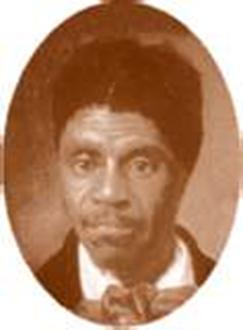
By the mid-1850's,
only the Supreme Court seemed to have nationwide authority and respect.
However, in 1857,
the court lost even that level of authority when it ruled in its Dred Scott
Decision that African Americans could not be citizens of the
(http://www.historyplace.com/lincoln/dred.htm)
Dred Scott was an
African-American slave who was taken by his master, an officer in the U.S. Army,
from the slave state of Missouri to the free state of Illinois and then to the
free territory of Wisconsin. He lived on free soil for a long period of time.
When the Army
ordered his master to go back to
In March of 1857,
Scott lost the decision as seven out of nine Justices on the Supreme Court
declared no slave or descendant of a slave could be a
22
Underground Railroad Backdrop
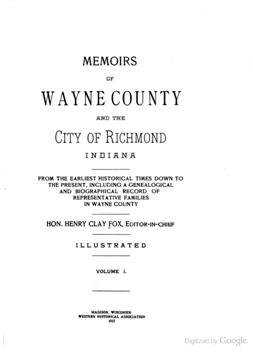
Now that we've been
through a laundry list of the ever-changing, politically expedient compromises
and national-level laws and events that was the backdrop for the operation of
the Underground Railroad, let's take a look at that same era through the eyes of
our
23.
Underground Railroad Backdrop
}
Memoirs of
◦
Strongest element – freedom from war and slavery.
◦
Influenced by teachings of George Fox
◦
Friends first engaged in importation of slaves
◦
Viewpoint changed to anti-slavery
◦
part of governmental
affairs
◦
Quakers escape to
}
Here are some
excerpts from: Chapter XI, "
}
"The strongest
element that settled in and around the town (of
}
"Early in the history of the Nation
(1750-1760) the Friends were agitating over the question of war, their early
impressions being influenced by the teachings of George Fox. They often had to
suffer for this, either by fines or imprisonment, and during the Revolution
their peace policy caused them to be regarded by many as hostile to American
} "As to slavery, the Friends first engaged in the importation of slaves, but early in their history a few became opposed to the practice. Many early slave holders were honest in believing that it was a Christian act to bring the colored people from their regions (Africa) of ignorance and superstition to those (America) of intelligence. The Friends had the feeling that they could better care for the slaves and that their buying them would bring them under better influence."
}
Over time, this
viewpoint changed. Although some slaves fell into good hands, these were few
compared to the many who were ill treated. Their opinion was that the slaves did
not come here to
}
Excerpts from:
Chapter XI, "
} "The Society of Friends became united in forbidding the practice of holding slaves by the members. A query required to be answered at that time (1750-1800) was: "Are Friends clear of purchasing, disposing of, or holding mankind as slaves?""
} "As this Quaker element against slavery in Carolina and Virginia became stronger and stronger, so the element favoring it became stronger and stronger, and gradually came to look upon the Quakers with suspicion, also refused them a part in the governmental affairs, and later inflicted punishments upon them. This state of affairs was not to be and could not be continued."
}
Quakers started to
make their exit from the Carolinas and
24.
Underground Railroad Backdrop
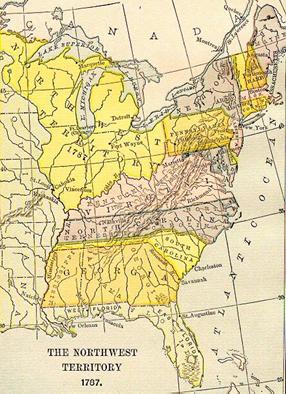
Excerpts:
"How fortunate for
them (Quakers) that there was a way to escape. In 1787 the
Excerpts from:
Chapter XI, "
"After
the agitation and settling of the
"Most
of the immigrants came from
25.
Underground Railroad Backdrop
}
Memoirs of
◦
Immediate vs. gradual emancipation….
◦
Organized societies, worked the press
◦ "brickbats, stones and rotten eggs were some of the arguments we had to meet"
◦ "Pro-slavery party still held the reins of government"
◦
Weekly "Protectionist" published
Excerpts from:
Chapter XI, "
"Some Friends believed in the immediate and unconditional emancipation, while others believed in a gradual emancipation or colonization. However, they were agreed on one thing, and that was, that the Negro should be freed."
"It is interesting to observe the
different ways different individuals went about to accomplish their purpose.
Some went about organizing societies; others worked through the press, while a
third class presented their ideas from the platform. There was in the East an
organization known as the Anti-Slavery Society. Friends at
" 'It tried a man's soul to be an
Abolitionists in those days, when brickbats, stones and rotten eggs were some of
the arguments we had to meet' " (Pg. 227 of "Reminiscences of Levi Coffin.")
… The anti-slavery sentiment steadily grew throughout the Nation, but the pro-slavery party still held the reins of government."
"Another
means of getting the people to see the evils of slavery was, as stated before,
through the press. In 1841 a press was established, issuing a weekly paper known
as the "Protectionist." This was the organ of the
((This paper favored
high tariff. In 1843 the "Free Labor Advocate," was established, with Benjamin
Stanton as the editor.))
Excerpts from:
Chapter XI, "
"The
purpose of the 'Protectionist' was first 'to awaken…the slave holding States to
a sense of their danger, and of the necessity for a remedy; to exhibit the
progressive infringements of the slave power upon our rights, or liberties, and
our prosperity; to demonstrate that slavery and liberty, being diametrically
opposed to each other, can never harmonize or long co-exist under the same
government; and finally, to show the abomination of the sin of slavery, and that
in all its features it is opposite to that of righteousness which exalteth a
Nation.
Second, to give
brief sketches of the most interesting foreign and domestic intelligence,
together with extracts and essays on subjects of a moral and religious nature.
In short, it is intended to make the 'Protectionist' a welcome visitor to every family where human liberty is regarded as the unalienable right of man; and that its columns shall be exclusively occupied with such matter as is useful to those who are desirous of walking in the ways of wisdom and truth.' "
Excerpts from:
Chapter XI, "
"The feeling that it
was wrong to use anything that had come in contact with slave labor was
continually growing stronger. … To condemn the slaveholder and then to use the
fruits of his slave’s labor was inconsistent. "The
26.
Underground Railroad Backdrop
Underground Railroad - Lines Converging on Levi Coffin's House

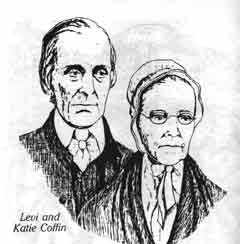
Excerpts from:
Chapter XI, "
"Siebert's "History of the Underground
Railroad" contains a map with … lines indicating the routes traveled by the
fugitive slaves.
Three lines
converged at Levi Coffin's house (in
"The
roads were always in running order, the connections were always good, the
conductors active and zealous, and there was no lack of passengers;" and almost
every week brought some of them. A light tap at the door almost any time of
night "was the signal announcing the arrival of a train of the Underground
Railroad, for the locomotive did not whistle nor make any unnecessary noise." A
train was made up of one or more of the covered wagons used in those days for
traveling. Since there was a continuous stream of immigration from the South to
the North, transportation in this way was very safe and easy. The number varied
from two or three to seventeen.
27.
Underground Railroad Backdrop
Levi Coffin House
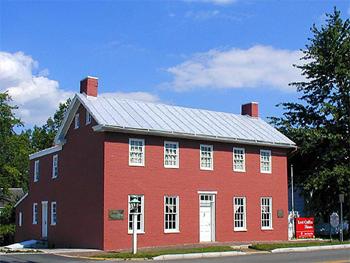
"Aunt Katie, as they
called Levi Coffin's wife, always got up and prepared food and beds for them, no
matter what time of night is was. The Coffins continued this work all the time
they lived at
28.
Underground Railroad Backdrop
Levi Coffin House Bedroom

29.
Ha(y)worth Participants
}
Joel Haworth – (
}
James Haworth – (
}
Joel Haworth –
}
Mahlon S. Haworth -
Following are
Ha(y)worth participants in the Underground Railroad that I could find records
for. Much of the information that follows is located on the
haworthassociation.org website.
30.
Ha(y)worth Participants
}
Joel Haworth – (
}
George & Sarah
(Scarborough),
à
James & Sarah (Wood),
à
Richard & Ann
à
Joel Haworth & Elizabeth (Maxwell)
}
Born - April 17, 1986,
}
Married - April 11, 1811,
Grassy Valley Meeting
}
Moved to
First, Joel Haworth
of
Shown is his lineage from "George the Immigrant."
George & Sarah (
(http://familytreemaker.genealogy.com/users/d/a/v/Mark-Davis-Valley-Village/WEBSITE-0001/UHP-0127.html
)
Joel Haworth was
born April 17, 1786 on his parent's Haworth Bend Farm on the Holston River,
Jefferson County, North Carolina (now Tennessee), approximately 25 miles above
Knoxville, TN. (Note: Mahlon Haworth would be born there in 1840).)
He married Elizabeth
Maxwell on April 11, 1811 in
"Joel Haworth moved
from Tennessee to Union County, Indiana, and bought a large tract of government
land at $1.25 per acre in gold… (eventually) he owned 1500 acres of land, 1000
acres of that land within
31.
Ha(y)worth Participants
}
Joel Haworth – (

Joel
Haworth died December 04, 1854, in Salem, Union County, Indiana. Both he and his
wife are buried at the
OBITUARY
"DIED-At his residence in Union Co., Indiana, on the 4th day of the 12th month,
1854, JOEL HAWORTH, of Flux and chronic affection of the bowels, aged 68 years,
7 months, and 16 days.
The deceased was confined to his bed in his last illness, three weeks. During a
considerable portion of this time, his sufferings were very great, all of which
was borne in much patience, calmness and Christian fortitude. He seemed to be
strongly impressed from near the commencement of his sickness that he would not
recover, of which he spoke during several interviews with his family, saying
that he felt a calmness to cover his mind that was not usual. Though at times he
thought he would like to live a while longer, that he might have been able to
have been with his dear companion and friends in the attendance of religious
meetings. He was an affectionate husband and tender father, and ever had a
sympathetic feeling for suffering humanity of whatever complexion or clime. In
his death the Religious Society of Friends has lost a devoted member, his family
a guardian protector, and the community in which he had lived for more than a
third of a century, a member whose place will be hard to fill."
[Source: A Standard
History of
32.
Ha(y)worth Participants
}
Joel Haworth – (
◦
"1884 Beers Atlas of
◦
Joel and Elizabeth present
at meeting establishing
At the
"He (John Beard) at one time assisted, with his father, in the escape of some
fugitives, who had permission to attend a "quilting" at a point opposite the
city of
Another source, (http://familytreemaker.genealogy.com/users/d/a/v/Mark-Davis-Valley-Village/WEBSITE-0001/UHP-0127.html
), states: "A large body of Indiana
Friends met at a convention of Friends at Newport, Wayne County, Indiana 2nd
month 6th, 1843 (February 6th) for the purpose of establishing the Indiana
Yearly Meeting of Anti-Slavery Friends "upon the true principles, and in
accordance with the discipline and usages of the Society of Friends." This group
of Quaker men and women were at odds with the larger body of Friends in
"Joel Haworth offered his home as a station on the Underground Railroad for a number of years."
33.
Ha(y)worth Participants
}
Joel Haworth – (
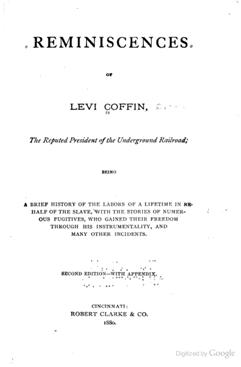
In Levi Coffin's
1876 book, "Reminiscences of Levi Coffin, the Reputed President of the
Underground Railroad," Joel Haworth's activity in giving safe harbor to runaway
slaves on The Underground Railroad was noted in a chapter chronicling the escape
of a woman named Ellen and her husband Louis. It states: "It was thought safer
for Louis and Ellen to go out of the city (
34.
Ha(y)worth Participants
}
James Haworth – (
}
George & Sarah (
}
1787 – Born
October 13th
}
1801 – Moved with parents to
}
1822 – Moved to
}
1824 – Moved to
}
Active in helping runaway
slaves (
Next, James Haworth
of
Shown is his lineage from "George the Immigrant."
George & Sarah (
"James was born October 13, 1787 in
"James
was about 13 in 1801 when his parents left
"In 1822, when James and his family moved
to
"In 1824, James bought 160 acres near
During this time,
James was active in helping runaway slaves as an article from the Indiana
Historical Society Publication, the Underground Railroad, indicates:
"There was a party of 4 fugitives at James Hayworth's house nearby, and it was
arranged that the next morning Levi Coffin would take one of them into his
carriage and Hayworth would take three in his and they would all proceed north
together. (Levi Coffin was President of the Underground Railroad)
(http://www.haworthassociation.org/Family-Notes/Joel-Haworth/James-father-of-Joel.htm
)
35.
Ha(y)worth Participants
}
James Haworth – (
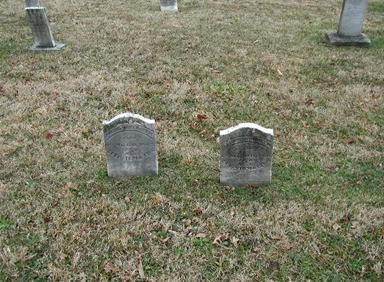
James died in 1866.
He was 79 and is buried in
36.
Ha(y)worth Participants
}
Joel Haworth – (of
}
George & Sarah (
}
At age 3, moved with family
from Ohio to Indiana
}
1841 – Married Sarah McKee
}
1850 – Moved to
}
1854 – Moved to
Next, Joel Haworth
of
Shown is his lineage from "George the Immigrant."
George & Sarah (
Joel was born in
He married Sarah
McKee there in 1841.
They lived in
The family moved to
37.
Ha(y)worth Participants
}
Joel Haworth – (
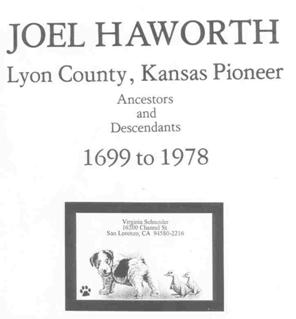
A book titled: Joel
Haworth - Lyon County, Kansas Pioneer, Ancestors and Descendants 1699 to 1978",
Compiled by Louise Rhodes Baker, Virginia Baker Schneider, and Aletha Pearl
Thomas, was published May 1 1978.
The book includes
the following information:
Joel Haworth moved
his family to Lyon County,
The following
excerpt also comes from the book:
"An attempt was made
about the last of December to kidnap a Negro named Charley, who lived with Joel
Haworth, about seven miles west of
Other References:
William G. Cutler's
History of the State of Kansas
was first published in 1883 by A. T. Andreas, Chicago, IL
http://www.kancoll.org/books/cutler/lyon/lyon-co-p1.html
The Early History of
by William G. Cutler (1883)
http://www.genuinekansas.com/county_lyon_county_kansas.htm
38.
Ha(y)worth Participants
Wagon with False Bottom
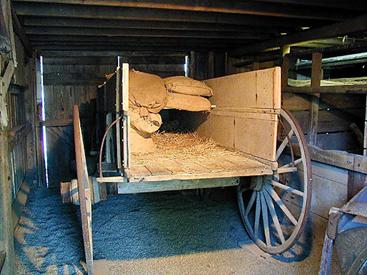
"The next morning
the Negro, dressed in a suit of women's clothes, was put in a wagon and started
for
Other Information:
http://www.news-record.com/content/2007/11/11/article/tracking_the_underground_railroad
"The
Mendenhall Plantation in
"The late Cecil E.
Haworth, a retired Quaker minister, was instrumental in overseeing the safe
passage of this old wagon with a false bottom from the barn on the farm of
Stacey and Ruth Hockett of

This is a picture of
the large house that Joel built on his farm overlooking the Cottonwood Valley
using the native lumber sawed at his sawmill.
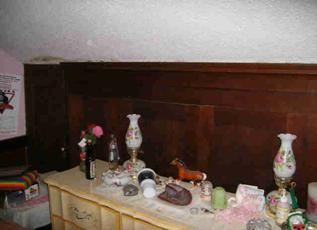
The

Hiding space in
built-in cupboard.
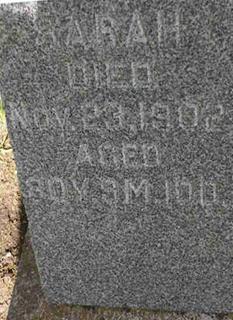
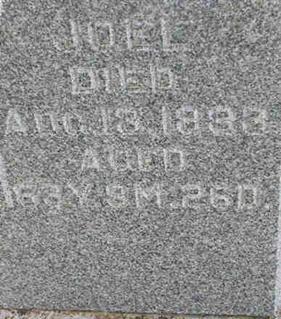
Grave stones of
Elizabeth and Joel Haworth (1819-1893)
Joel was born in
1819 and died on August 13, 1883, at the age of 63.
Joel was buried in
the Haworth Cemetery in Emporia, KS, which is on land he presented to the public
for burial.
39.
Ha(y)worth Participants
}
Mahlon S. Haworth
}
George/Sarah (
Finally, Mahlon S.
Haworth of
Shown is his lineage
from “George the Immigrant.”
George/Sarah (

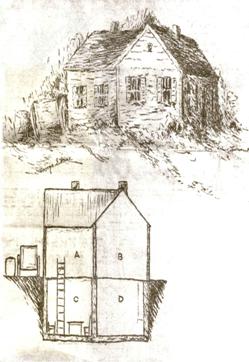
Date line:
George Shane, Des Moines Sunday Register, August 4, 1929
http://www.haworthassociation.org/Family-Notes/Mahlon/mahlons_house.htm
"Upper picture
represents the Mahlon Hayworth house as it was when used for an Underground
Railroad station. The lower drawing is a diagram showing secret cellar
arrangement. Slaves would enter room marked A and climb down ladder to
subterranean chamber labeled C, where they would hide with minimum danger of
discovery. Section of basement marked D is walled off from other portion,
with no connection except a tunnel between the partitions. The tunnel
provided a second exit in case raiders were to find the upper trap door and come
down the ladder. Entering the tunnel in the hollow partitions, which
extended around part of cellar marked D, the slaves could make a getaway through
an exit on the opposite side of the building. Room labeled B "was the
Hayworth parlor."
"These
pictures were sketched by George Shane, writer of the accompanying story.
Des Moines Sunday Register, August 4, 1929,
titled “Find Secret Tunnels in Indianola House," and transcribed on the Haworth
Association website by
George Shane,
The article is on
the haworthassociation.org website, thanks to the transcribing work of
http://www.haworthassociation.org/Family-Notes/Mahlon/mahlon_haworth.htm
Title:
Find Secret Tunnels in Indianola House
Sub title: Slaves Hid there in days of the Underground
Railway
Date line: George Shane,
"A
house in Indianola, once one of the most important links in the Underground
Railroad system, was torn down last week in order that the world may have
another filling station. Where bright and shinny red gasoline pumps soon will be
erected for the benefit of tourists who drive along this elm shaded bit of the
Jefferson highway, Mahlon Hayworth, a Quaker and advocate of liberty, built the
dwelling seventy-one years ago.
Facts Are Few
"There
are obscure legends in Indianola about the house; but facts are not numerous. It
is established, however, that fugitive slaves were hidden there when pursuit
from the south grew warm. This Quaker residence was a vital point in the
southern branch of the Underground Railroad. Mahlon Hayworth was an avowed
abolitionist; he was willing to speak freely on the impositions of slavery, but
his activities in abating the system he believed evil were affairs he declined
to mention in conversation. Were his acts known, he could have been sent to
prison for six months and fined $1,000 under the federal fugitive slave law.
Trap Door Hidden
"The
house was constructed to aid him in carrying out his beliefs. The basement was
divided into two compartments-one of them a secret chamber. Runaway Negroes,
bound for
Negroes Easily
Pleased
"At
night a wagon would arrive from Winterset and a few dark figures would enter the
house. Hayworth would lead his fugitive guests to the kitchen, open the trap
door, and help them down a ladder to the room below. There the escaping slaves
found a neat chamber with plastered walls, chairs and beds. The place was no
more than sixteen or eighteen feet long and a dozen feet wide. But cramped
quarters did not trouble the Negroes. They were in one of the most carefully
designed Underground Railroad stations on the route from the south to
Much Hidden History
"This
much is known of Hayworth's abolitionist activities. A far greater amount of
slave running history has died with him and his brother Quakers. The stations
southwest of Indianola on this particular line were Winterset, Lewis, Tabor and
Percival. Where the fugitives were taken for the next stop after they climbed
out of the subterranean room is unknown. It is possible that the next station on
the route was at
Remains a Mystery
"And Hayworth and
his friends did their worst for the southerners. They kept no schedules of
arrivals and departures. The trail north from Indianola was their secret, and it
still remains a mystery. Object lessons had taught Hayworth that precautions
were necessary. He built his house so that every protection was available.
Leading from the secret chamber was one exit in addition to the trap door. It
was a tunnel running through a double wall in the other part of the cellar. This
exit had been arranged to allow the fugitives a means of escape should slave
chasers or federal officers find the upper trap door and climb down the ladder.
Few stations in
Buildings Ransacked
"Often
the homes of other abolitionists were turned topsy-turvy by raiding officers.
Farm buildings were ransacked, Negroes were arrested and searches conducted
without warrants or proper information. One historian in writing of such events
said "federal marshals empowered by congress to enter
Like Modern
Bootleggers.
"Congregationalists
and Methodists were inclined to sympathize with the Negro's cause and joined the
Quakers in the operation of the Underground Railroad. None of these faiths was
safe from raids. Their homes were searched at all hours of the night. Frequently
it was proved that the slave hunting officers were intoxicated at the time of
their ransacking. Those who aided the Negro in escaping often had no more
approval than the bootlegger of today. When the question was debated it was
insisted that the abolitionists should respect the law though they did not
believe in it. It was the will of the majority, it was said. But the slave
sympathizers argued in the name of personal liberty and continued to aid the
Negro in his attempt to reach
Risked Suffocation
"Hayworth,
to be sure, escaped detection but one of his brother Quakers, Benjamin Henshaw,
received a violent visit from the slave raiders. A group of officers had heard
slaves were in hiding on the Henshaw farm, a mile east of Indianola. The
officers rode out to the farm and demanded that Henshaw turn over the fugitives.
The Quaker denied knowledge of runaway slaves and went about his work
peacefully. The house and farm buildings were searched. Everything on the place
where a human might be in hiding was pulled apart. But no slaves were found.
When the raiders departed, Henshaw scooped seed corn from three barrels and
helped three Negroes out. The fugitives had been willing to risk suffocation in
order to escape.
"Disrespect
for Laws"
"Such
incidents were not uncommon near Indianola. From time to time the penalties were
made more severe. Those who encouraged as well as those who aided a slave to run
away from his master were liable to punishment. But abolitionists increased in
numbers and invariably there was someone willing to warn of impending raids. A
southern congressman lamented, saying that disrespect for law increased though
the penalties became more drastic. A northern member of the legislature insisted
that the illegal activities of the Underground Railroad were grossly
misrepresented and, in reality, the fugitive slave law was respected.
The Rebellion Began
"The
debate over the prohibition of aiding escaping slaves became intense and as the
abolitionist sentiment grew, Underground Railroad stations in
40.
Ha(y)worth Participants
}
What was the Underground
Railroad?
}
Background of the
Underground Railroad
}
Ha(y)worth Participants on
the Underground Railroad
In summary, The
Underground Railroad was a clandestine system for transporting escaped slaves
out of slave states.
Its origins grew
from a paradigm shift of attitudes regarding slaves and slavery that were tested
for many years in the executive, legislative and judicial systems of the
Participation in The
Underground Railroad was a dangerous, rebellious and illegal activity, and our
Ha(y)worth ancestors were in the thick of it.
Thank You!